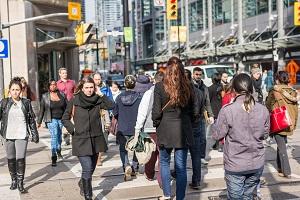Of all the modes of transport, walking is probably the one we think the least about; indeed, walking has gained little recognition in this regard, with some referring to it as an “invisible” mode of transport. As such, it is often forgotten when planning and designing transport networks, in urban planning and in investment decisions. This limits the potential benefits that walking can have for the environment and in meeting international commitments towards limiting the changes in our climate, which must be addressed in a systematic and systemic way. Walking could be considered as the “missing link” in multimodal transport planning and the promotion of sustainable mobility.
Walking is also highly efficient in its use of urban space and energy, and has significant physical and mental health benefits. The indirect benefits of walking include an increase in green spaces through a greater need for traffic-free spaces. In turn, such green spaces can contribute to the fight against biodiversity loss. Moreover, one social benefit of walking is the increased perception of safety and confidence within communities as more people choose to walk. Economic benefits should also be considered; for instance, research in the United States of America has shown that interventions targeting an increase in walking can lead to a rise of up to 40 per cent in the number of people entering shops and buying goods or services.
In recent years, mainly in urban areas, initiatives to design and redesign places to promote walking and cycling have been launched. Networks of cities and organizations such as POLIS have supported these developments. However, different elements must be considered when planning an increase in walking modal share. These extend from the development of infrastructure – which must consider the needs of persons with reduced mobility, for instance – to the design of walking routes. Investments in walking-related measures are good value for money compared with other transport investments; however, few resources are made available, often due to a lack at all levels of government of resources dedicated to walking. There is a tendency to consider that local-level authorities have competence regarding walking; however, often, they do not receive relevant targeted resources, one reason being the low level of awareness at the national level. In addition, cities depend on various frameworks developed at the national and supranational levels. Whilst urban areas are often the most active on promoting walking, small towns and peri-urban areas lag behind. These challenges require coordination between all levels of governance.
With the foregoing in mind, the Transport, Health and Environment Pan-European Programme (THE PEP) has started working on a master plan on walking. The task was mandated by the 2021 Vienna Declaration of the Fifth High-level Meeting on Transport, Health and Environment “Building forward better by transforming to new, clean, safe, healthy and inclusive mobility and transport” and is being implemented by THE PEP Partnership on Active Mobility. At the invitation of the Government of France, the Partnership met in Paris and online on 25 and 26 April 2022 to discuss the preparation of a pan-European master plan.
The goal is to provide a framework and a guide that national authorities could apply to prepare national action plans on walking. Member States could use the master plan to develop a clear strategy for walking, followed by an action plan that makes the Government accountable for establishing national policies and resources to be devoted to walking.
Representatives of 15 member States of the UNECE and World Health Organization Regional Office for Europe region attended the meeting, along with two advocacy organizations, Walk21 and POLIS. Member States shared their varying levels of experience in the implementation or preparation of action plans on walking. Some countries, including Austria and Norway, had already launched national plans, whereas others, such as Turkey, were starting to work on the issue and were seeking advice and examples of good practices from other countries. Countries’ experiences show that a strategy at the national level increased cooperation and coordination in the area between the national and local levels. A survey conducted prior to the Partnership meeting highlighted shared expectations and desires amongst member States along different axes such as research, planning and investments in walkable cities.
The pan-European master plan on walking is to be adopted in 2025 at the Sixth High-level Meeting on Transport, Health and Environment. The next Partnership meeting will be hosted by the Government of Ireland as part of the Walk21 conference in Dublin on 19–23 September 2022.


